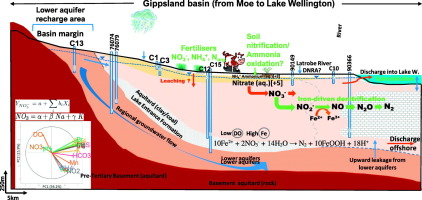当前位置:
X-MOL 学术
›
Sci. Total Environ.
›
论文详情
Our official English website, www.x-mol.net, welcomes your feedback! (Note: you will need to create a separate account there.)
Controls on species distribution and biogeochemical cycling in nitrate-contaminated groundwater and surface water, southeastern Australia.
Science of the Total Environment ( IF 9.8 ) Pub Date : 2020-04-08 , DOI: 10.1016/j.scitotenv.2020.138426 S Michael Adelana 1 , Michael W Heaven 2 , P Evan Dresel 3 , Khageswor Giri 1 , Mark Holmberg 3 , George Croatto 4 , John Webb 5
Science of the Total Environment ( IF 9.8 ) Pub Date : 2020-04-08 , DOI: 10.1016/j.scitotenv.2020.138426 S Michael Adelana 1 , Michael W Heaven 2 , P Evan Dresel 3 , Khageswor Giri 1 , Mark Holmberg 3 , George Croatto 4 , John Webb 5
Affiliation

|
A detailed study of groundwater and surface water nitrate over four seasons across an area of varied landuse provided insights into the mechanisms that underlie accumulation and transport of nitrate. High nitrate concentrations found in a significant percentage of surface water and shallow groundwater samples are due to anthropogenic contamination. Statistics (PCA, ANOVA, parsimonious model and general linear regression) were used to explore the relationship between NO3- and land use, and confirmed that areas of high NO3- concentration are associated with dairy pasture and horticulture. Seasonally, NO3- levels are greater during winter, the wettest part of the year. Values of δ15N showed that most nitrate is sourced from livestock waste, with a smaller contribution from synthetic fertilizer. Direct wash-off of animal waste from dairy farms results in higher NO3- concentrations in surface water than in groundwater. Denitrification is an important NO3- attenuation mechanism which reduces NO3- to NH4, as demonstrated by the PCA analysis, which showed positive correlation of NO3- concentrations with dissolved oxygen and negative correlations with NH4+, Fe2+and Mn2+; the latter two species may act as the electron donors necessary for reduction of NO3-. The often high NO3- concentrations in shallow groundwater are decreased by denitrification, which can occur at relatively shallow depths (<3 m). The relatively small NO3- concentrations in deeper groundwater are due partly to denitrification, but more to originally lower NO3- concentrations, as the age of deeper groundwater shows that it was recharged before agriculture was established in the study area. Overall, the study demonstrates the usefulness of hydrogeochemical characterisation and multivariate statistics in the evaluation of impacts of agricultural land-use on regional N cycling. In particular, the results show that efforts to mitigate NO3- pollution from farms should concentrate more on wash-off of animal waste than the contribution of nitrogenous synthetic fertilizer.
中文翻译:

澳大利亚东南部受硝酸盐污染的地下水和地表水中物种分布和生物地球化学循环的控制。
在四个不同土地利用区域的四个季节中对地下水和地表水硝酸盐的详细研究,为了解硝酸盐积累和运输的基础机制提供了见识。在很大比例的地表水和浅层地下水样品中发现高硝酸盐浓度是由于人为污染造成的。统计数据(PCA,ANOVA,简约模型和一般线性回归)用于探究NO3-与土地利用之间的关系,并确认NO3-高浓度地区与牧场和园艺相关。从季节来看,冬季(一年中最湿的部分)中的NO3水平较高。δ15N的值表明,大部分硝酸盐来自牲畜废物,而合成肥料的贡献较小。从奶牛场直接冲走动物粪便会导致地表水中的NO3-浓度高于地下水。如PCA分析所示,反硝化是将NO3-还原为NH4的重要NO3-衰减机理,PCA分析表明NO3-浓度与溶解氧呈正相关,与NH4 +,Fe2 +和Mn2 +呈负相关。后两种可能充当还原NO3-所需的电子供体。反硝化作用降低了浅层地下水中通常较高的NO3-浓度,反硝化作用可能发生在相对浅的深度(<3 m)。在较深的地下水中,NO3-浓度相对较低,部分原因是由于反硝化作用,但更多原因是最初的NO3-浓度较低,因为较深的地下水年龄表明在研究区建立农业之前已对其进行了补给。总体而言,该研究证明了水文地球化学表征和多元统计数据在评估农业土地利用对区域氮循环的影响方面的有用性。尤其是,结果表明,减轻农场对NO3-污染的努力应更多地集中在动物粪便的冲刷上,而不是氮肥的贡献。
更新日期:2020-04-08
中文翻译:

澳大利亚东南部受硝酸盐污染的地下水和地表水中物种分布和生物地球化学循环的控制。
在四个不同土地利用区域的四个季节中对地下水和地表水硝酸盐的详细研究,为了解硝酸盐积累和运输的基础机制提供了见识。在很大比例的地表水和浅层地下水样品中发现高硝酸盐浓度是由于人为污染造成的。统计数据(PCA,ANOVA,简约模型和一般线性回归)用于探究NO3-与土地利用之间的关系,并确认NO3-高浓度地区与牧场和园艺相关。从季节来看,冬季(一年中最湿的部分)中的NO3水平较高。δ15N的值表明,大部分硝酸盐来自牲畜废物,而合成肥料的贡献较小。从奶牛场直接冲走动物粪便会导致地表水中的NO3-浓度高于地下水。如PCA分析所示,反硝化是将NO3-还原为NH4的重要NO3-衰减机理,PCA分析表明NO3-浓度与溶解氧呈正相关,与NH4 +,Fe2 +和Mn2 +呈负相关。后两种可能充当还原NO3-所需的电子供体。反硝化作用降低了浅层地下水中通常较高的NO3-浓度,反硝化作用可能发生在相对浅的深度(<3 m)。在较深的地下水中,NO3-浓度相对较低,部分原因是由于反硝化作用,但更多原因是最初的NO3-浓度较低,因为较深的地下水年龄表明在研究区建立农业之前已对其进行了补给。总体而言,该研究证明了水文地球化学表征和多元统计数据在评估农业土地利用对区域氮循环的影响方面的有用性。尤其是,结果表明,减轻农场对NO3-污染的努力应更多地集中在动物粪便的冲刷上,而不是氮肥的贡献。


























 京公网安备 11010802027423号
京公网安备 11010802027423号